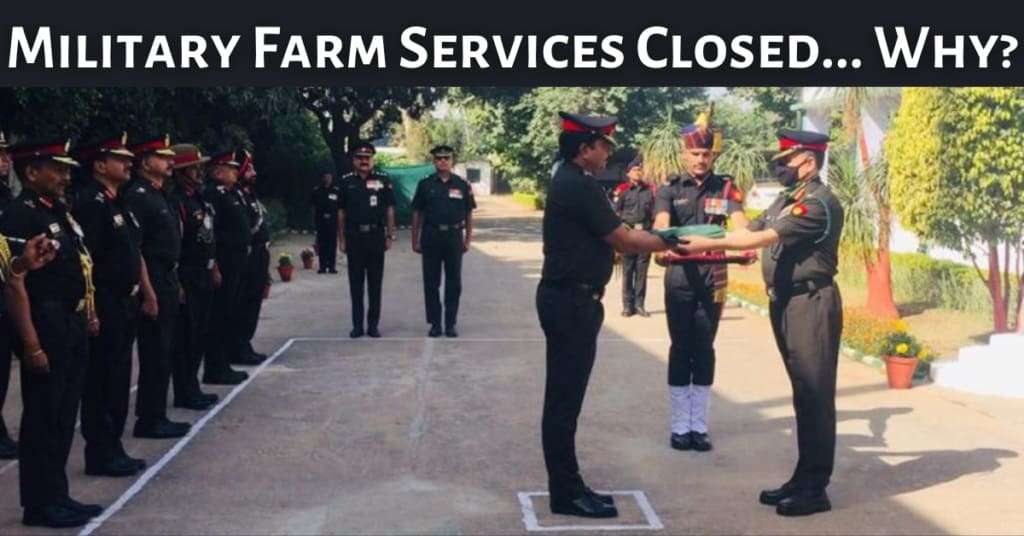31st March 2021 not only ended the financial year of 2021 but also bought curtains down to the 130-year-old Military Farm Services as the Indian Army formally closed them. A formal ceremony was organized to close all the 39 military farms across the country. The flag of the Military Farm Services was lowered for the ultimate time during a dignified ceremony held at Delhi Cantonment.
But many of you would have heard the name “Military Farm” for the first time. So, let’s understand what the Military Farm Services is, why they were established, and what led to their closure.
What are the “Military Farm services”?
The Military Farms is a quasi-commercial organization which were formed basically for the below roles:-
- Uninterrupted supply of fresh milk and dairy products to troops in peace, field, and high altitude areas at their location on daily basis.
- Production, procurement, transportation & issue of baled hay to AT Units at their designated place as per demand.
The first Military Farm was set up by the Britishers on 1 February 1889 with the formation of the Military Farm at Allahabad.
These Military farms were spread over an area of 20,000 acres of prominent defense land and had over 25,000 livestock. During its peak, there were around 130 farms which have been reduced currently to 39 military farms.
Military Farms are located across India majorly at Ambala, Jalandhar, Pathankot, Jammu, Srinagar, Kargil, Udhampur, Meerut, Ranikhet, Ahmednagar, Gwalior, Jabalpur, Secunderabad, Mhow, Jhansi, Dimapur, Guwahati, Jorhat, Panagarh, Kolkata, Agra, Prayagraj, Lucknow, and Kanpur among others.
As things changed, the Military Farms had expanded their role from only milk production to artificial insemination and breeding of cows too and the first advanced steps in this area were taken as early as 1925.
At one point the Indian Council for Agricultural Research (ICAR) had found Military Farms were the largest holders of Livestock in the country. Partnering with the Ministry of Agriculture, the Military Farms undertook ‘Project Frieswal’ which later became one of the largest cross-cattle breeding programs in the world.

Why they were required?
During the formation of military establishments, they were largely isolated from towns and cities. But with rapid urbanization, most cantonments have now come within population clusters. Further, The White Revolution of the 1970s has changed things altogether. Milk availability is not an issue now. For the last 20 years, India has been the largest producer of milk in the world.
Military Farm services in India were established to ensure a clean and continuous supply of cow’s milk to troops located in various military locations across India. After Indian independence, the Indian Army not only continued their service but also expanded them.
Assets created by Military Farm services
After Indian Independence, the farms flourished and during its peak, they had around 30,000 heads of livestock in 130 farms all over the country. Military farms were even started at Leh and Kargil in the late 1990s.
How was used by the Indian Army to facilitate its troops
Since their inception, the Military farm services with full dedication and commitment have supplied on an average 3.5 crore liters of milk and 25,000 MT of hay yearly.
Military farms are also credited with pioneering the technique of artificial insemination of cows and the introduction of organized dairying in India. They gave yeoman service during the 1971 Bangladesh liberation war, providing milk at both the Western and Eastern war fronts. They also helped in providing continuous milk supply during the Kargil operations in 1999, to the Northern Command
Major contribution done by the Military farm services
The Military Farms are the ones that introduced Artificial Insemination (AI) in livestock in the early 20th century. The improvement of the Dairy Industry as an organized sector in the country is accredited to them. The Head of Military Farm in 1946-47 was also the Imperial Dairy Expert of the country.
In collaboration with the Ministry of Agriculture, they organized “Project Freiswal” to improve the quality and quantity of milk production. They also collaborated with the Defence Research and Development Organisation (DRDO) in the research & development of bio-fuel in the country.
Project “Freiswal”
- It was a collaborative project of national importance being undertaken by the Military Farms with the Indian Council of Agriculture Research (ICAR), Ministry of Agriculture.
- It is considered to be one of the world’s biggest cross-breeding programs that envisages evolving a milch breed of cattle for the tropical world.
- Its aim was to produce and rear crossbred cattle of HF x Sahiwal Crosses (62.5% HF) for high milk productivity under Frieswal Project.
- A memorandum of understanding (MOU) was signed between the Ministry of Agriculture and the Ministry of Defence on 14 Sep 1991. The main aim of the project was to develop a good quality breed yielding 4000 kgs in 300 days lactation with 4% butterfat.
- Over 14,000 cattle had been produced by the Military Farms in this project for the Nation since 1993.
Collaborative BioFuel Generation Programme of DRDO
- .Under the joint collaborative Project with Military Farms, the DRDO has carried out a large-scale plantation of Jatropha in the following the Military Farms for biodiesel production as an alternative source of energy.
- The Project commenced in 2007 and is presently making steady progress with the establishment of a biodiesel esterification plant at Military Farm, Secunderabad.
| Sr No | Name of Farm | Area |
| (i) | MF Secunderabad | 170 Acres |
| (ii) | MF Ahmednagar | 500 Acres |
| (iii) | MF Mhow | 250 Acres |
How things started changing for Military farm services
There have been many repeated recommendations in the past to close the Military farm services as their main purpose of supplying uninterrupted High-Quality milk can be fulfilled by procuring directly from the open market.
The Major announcement came in June 2013 when the Quarter Master General’s branch of the Army Headquarters, under which the Military Farm services fell, issued a notification that the farms will be closed in a phased manner. The evolution of the dairy business in the country had secured that fresh and high-quality milk could be purchased in every corner of the country. There was no longer any forced dependence on them.
In June 2014, another instruction came from the Deputy Director-General Military Farms that the responsibility of purchasing and distrusting milk and milk products were being shifted from Military Farms to Army Service Corps (ASC).
In 2016, a committee headed by Lt Gen DB Shekatkar, PVSM, AVSM, VSM (retd), which was formed to rebalance the defense spending on the Armed forces, submitted a comprehensive report on the reorganization of various branches of the Indian Army. The report recommended that the Military Farms must be shut.
Future of Current Assets & employees of Military farms
The Ministry of Defence has instructed the Chief of Army Staff in May 2018 to sell all the livestock held by the Military farms to central or state dairy departments or state dairy cooperatives at a very minimal amount of ₹ 1,000 per cattle.
The market price of the Hybrid Frieswal cows at the time was around ₹ 1,00,000 per cow. However, the minimal price was charged to ensure the full transfer of the cows from the Military Farms to the transferring organisations. Around 25,000 cows were with the Military Farms in 39 different farms when the decision was announced by the Defence Ministry.
The permanent staff of the Military Farms has been shifted to different departments of the Ministry of Defence. The Majority of them are civilian personnel.
In the last few years, there were no permanent recruitments in the Military Farm services and temporary employees had been employed in different departments of the Ministry of Defence.
How Shutting down Military Farm services will affect Defence Budget
The government is trying to save around Rs 280-300 crores per year which was spent on the upkeeping and maintaining of these Military farms, the Livestock, and the salaries of the staff of Military Farm Employees.
Further, there are nearly 20,000 acres of land at the prime location throughout the country which belongs to the Military Farm Services. The Ministry of Defence will take a final decision as to how this land will be utilized. It is assumed that it will be used for different activities by the three defense services. Yet there is no clear picture.


